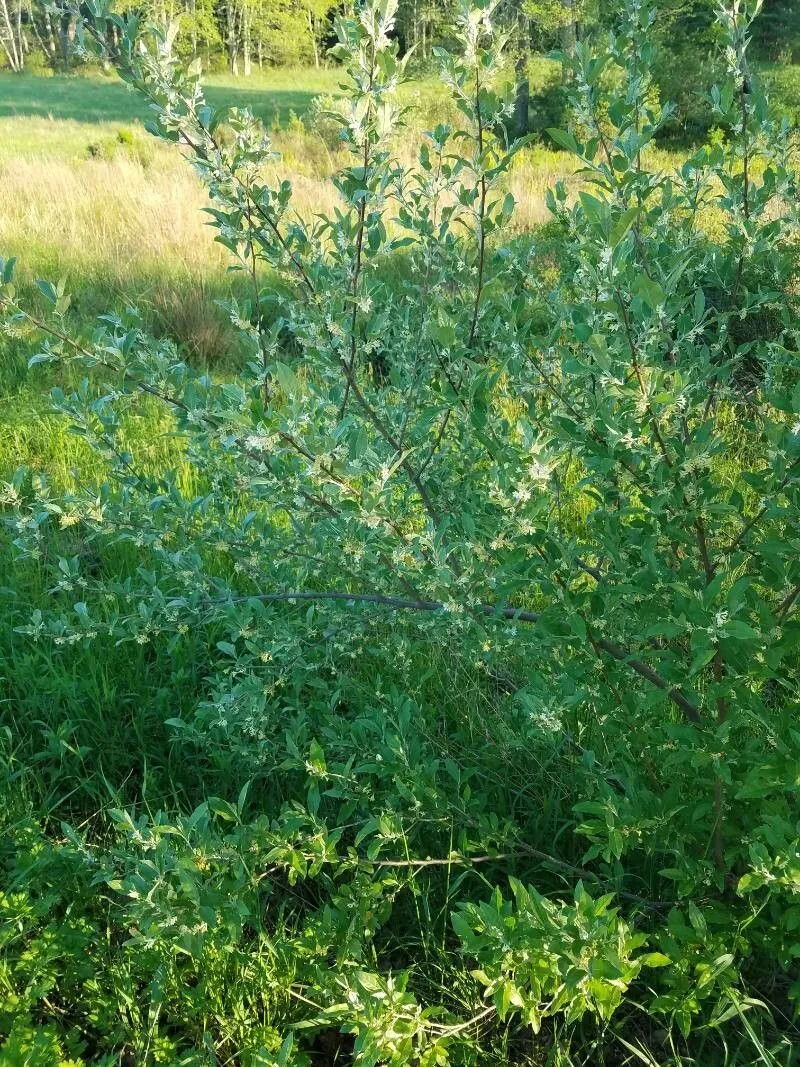
Author: Thunb.
Bibliography: J.A.Murray, Syst. Veg. ed. 14: 164 (1784)
Year: 1784
Status: accepted
Rank: species
Genus: Elaeagnus
Vegetable: False
Observations: Afghanistan to Temp. E. Asia
Spreading oleaster, scientifically known as Elaeagnus umbellata, is a versatile and resilient shrub native to a wide range extending from Afghanistan to temperate regions of East Asia. Initially described in the late 18th century by the botanical authority Thunberg, and chronicled in J.A. Murray’s “Systema Vegetabilium” during its 14th edition in 1784, this species has long been recognized for its distinctive characteristics and adaptability.
Elaeagnus umbellata belongs to the Elaeagnaceae family, a group known for plants that often thrive in challenging environments, making them valuable for various ecological restoration efforts. One of the key features of the spreading oleaster is its ability to improve soil quality through nitrogen fixation. This process involves symbiotic bacteria that convert atmospheric nitrogen into a form usable by plants, enriching the soil and benefiting surrounding vegetation.
The shrub is typically found in a variety of habitats, from open fields to forest margins, and is often planted in reclamation projects due to its hardiness. It can reach a height of roughly 3 to 6 meters, with silvery green foliage that gives it a distinctive appearance throughout the growing season. In the spring and early summer, Elaeagnus umbellata produces small, fragrant, cream-colored flowers, which are followed by abundant clusters of small, red to orange berries in the fall. These berries are not only ornamental but also edible, often used in jams and jellies, and are enjoyed by various bird species.
The berries of the spreading oleaster are rich in lycopene, a powerful antioxidant, which has garnered attention for its potential health benefits, including support for cardiovascular health and possible cancer-preventative properties. Additionally, the shrub’s dense growth habit provides excellent cover and nesting sites for wildlife, contributing to biodiversity in the areas it inhabits.
Despite its benefits, Elaeagnus umbellata has also been noted for its invasive potential in non-native regions, particularly in North America. Its prolific seed production and rapid growth allow it to outcompete native plant species, leading to monocultural stands that can alter local ecosystems. Consequently, management and careful consideration are recommended when introducing this species to new areas.
In summary, the spreading oleaster (Elaeagnus umbellata) is a noteworthy plant with significant ecological and nutritional value, though it requires mindful management to prevent its spread in non-native environments. Its resilience and adaptability continue to make it a species of both interest and utility in various botanical and ecological contexts.
Eng: autumn elaeagnus, autumn olive, autumn-olive, oleaster, spreading oleaster, autumn berry
Deu: doldige ölweide, doldige, ölweide
Fra: oléastre réfléchi, oléastre à ombelles, chalef en ombelles
Dan: skærm-sølvblad
Por: elaeagnus, eleagnus
Swe: koreansk silverbuske
Hun: pirostermésű ezüstfa
Nld: schermolijfwilg
Jpn: aki-gumi
Lat: elaeagnus
Spa: fresa de otoño, fresa japonesa, fresa plateada
Zho: niu nai zi, qiu hu tui zi
Cym: oleaster
En: Spreading oleaster, Autumn elaeagnus, Autumn-olive, Autumn olive, Oleaster, Autumn berry
Zh: Niu nai zi, Qiu hu tui zi
Da: Skærm-sølvblad
Nl: Schermolijfwilg
Fr: Oléastre réfléchi, Oléastre à ombelles, Chalef en ombelles
De: Doldige Ölweide, Doldige, Ölweide
Hu: Pirostermésű ezüstfa
It: Eleagno, Olivagno
Ja: Aki-gumi
La: Elaeagnus
Pt: Elaeagnus, Eleagnus
Es: Fresa de otoño, Fresa japonesa, Fresa plateada
Sv: Koreansk silverbuske
Cy: Oleaster
© copyright of the Board of Trustees of the Royal Botanic Gardens, Kew.
© copyright of the Board of Trustees of the Royal Botanic Gardens, Kew.
© copyright of the Board of Trustees of the Royal Botanic Gardens, Kew.
Taken Sep 16, 2021 by Bagus Bagus (cc-by-sa)
Taken Mar 18, 2018 by Colette Ulrich (cc-by-sa)
Taken Dec 1, 2021 by Filobaso (cc-by-sa)
Taken Nov 20, 2022 by Dylan Gunning (cc-by-sa)
Taken Oct 20, 2017 by Filip Košić (cc-by-sa)
Taken Jul 5, 2021 by Jenny Jennifer (cc-by-sa)
Taken Nov 22, 2021 by Hervé Huntzinger (cc-by-sa)
Taken Nov 22, 2021 by Hervé Huntzinger (cc-by-sa)
Taken Nov 4, 2022 by Chris Bunyan (cc-by-sa)
Taken Nov 26, 2021 by Caroline Lefèvre (cc-by-sa)
Taken Mar 23, 2022 by Jérôme Rousselle (cc-by-sa)
Taken Aug 2, 2021 by M Swadron (cc-by-sa)
Taken Oct 15, 2022 by Caw Vus (cc-by-sa)
Taken Feb 1, 2022 by André Keller (cc-by-sa)
Taken Nov 22, 2021 by Hervé Huntzinger (cc-by-sa)
Taken May 13, 2014 by EOL − srall (cc-by-nc)
Taken Apr 14, 2021 by The Southern Lady (cc-by-sa)
Taken Apr 13, 2019 by Bowling Tim (cc-by-sa)
Taken Oct 17, 2019 by Checchi Fabrizio (cc-by-sa)
Taken Sep 11, 2012 by EOL − Adam C. Bad Wound (cc-by-nc-sa)
Taken May 21, 2022 by Shari Branning (cc-by-sa)
Taken Apr 26, 2022 by jimseng jimseng (cc-by-sa)
Taken Apr 27, 2022 by Fabrice Rubio (cc-by-sa)
Taken Aug 23, 2022 by M C (cc-by-sa)
Taken Sep 19, 2021 by NaNo_ N9 (cc-by-sa)
Taken May 15, 2016 by Photoflora – Jean-Luc TASSET (©)
Taken May 11, 2016 by Tela Botanica − Dominique REMAUD (cc-by-sa)
Taken May 11, 2016 by Tela Botanica − Dominique REMAUD (cc-by-sa)
Taken May 23, 2021 by eyesny (cc-by-sa)
Taken May 25, 2015 by Tela Botanica − Liliane ROUBAUDI (cc-by-sa)
Growth form: Multiple Stem
Growth habit: Shrub
Growth rate: Rapid
Ph maximum: 7.5
Ph minimum: 5.3
Family: Myrtaceae Author: (F.Muell.) K.D.Hill & L.A.S.Johnson Bibliography: Telopea 6: 402 (1995) Year: 1995 Status:…
Family: Rubiaceae Author: Pierre ex A.Froehner Bibliography: Notizbl. Bot. Gart. Berlin-Dahlem 1: 237 (1897) Year:…
Family: Sapindaceae Author: Koidz. Bibliography: J. Coll. Sci. Imp. Univ. Tokyo 32(1): 38 (1911) Year:…
Family: Asteraceae Author: A.Gray Bibliography: Pacif. Railr. Rep.: 107 (1857) Year: 1857 Status: accepted Rank:…
Family: Fabaceae Author: Medik. Bibliography: Vorles. Churpfälz. Phys.-Ökon. Ges. 2: 398 (1787) Year: 1787 Status:…
Family: Aspleniaceae Author: (Cav.) Alston Bibliography: Bull. Misc. Inform. Kew 1932: 309 (1932) Year: 1932…